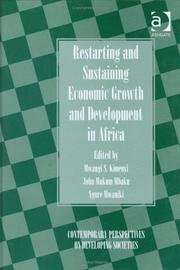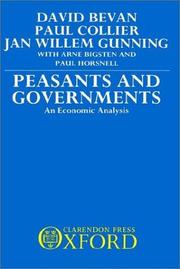| Listing 1 - 10 of 20 | << page >> |
Sort by
|

ISBN: 0754634728 9780754634720 Year: 2003 Publisher: Aldershot: Ashgate,
Abstract | Keywords | Export | Availability | Bookmark
 Loading...
Loading...Choose an application
- Reference Manager
- EndNote
- RefWorks (Direct export to RefWorks)
Economic growth --- Economic conditions. Economic development --- Kenya --- Africa --- Economic conditions --- Economic policy --- Kenya - Economic conditions - 1963 --- -Kenya - Economic policy --- Africa - Economic conditions - 1960 --- -Kenya - Economic conditions - 1963 --- -Kenya
Book
ISBN: 1616352620 Year: 2015 Publisher: Washington, D.C. : International Monetary Fund,
Abstract | Keywords | Export | Availability | Bookmark
 Loading...
Loading...Choose an application
- Reference Manager
- EndNote
- RefWorks (Direct export to RefWorks)
Following the approval of a new constitution in 2010, the authorities have embarked on important reforms including fiscal devolution, VAT reform, and the overhaul of the expenditure management framework. Supported by a three-year ECF, which expired in December 2013 with all six reviews completed, Kenya has consolidated macroeconomic stability. Growth has been robust, inflation contained, debt remained sustainable and reserve buffers increased (Tables 1a and 1b and Figures 1 and 2). This progress in a market-friendly environment has continued to attract the interest of foreign investors. As a result, Kenya is recognized as a frontier market increasingly integrated in global financial markets. A Eurobond debut issue of US$2 billion (the largest in SSA so far) took place successfully in June followed by a $750 million re-tap in December.
International monetary fund -- Kenya. --- Kenya -- Economic conditions. --- Kenya -- Fiscal policy. --- Kenya
Book
ISBN: 149831144X Year: 2014 Publisher: Washington, D.C. : International Monetary Fund,
Abstract | Keywords | Export | Availability | Bookmark
 Loading...
Loading...Choose an application
- Reference Manager
- EndNote
- RefWorks (Direct export to RefWorks)
KEY ISSUES Context: Kenya has embarked on major reforms in line with the 2010 constitution. The new government has started the process of devolution at a fast pace, introducing a reporting framework that allows for monitoring progress and challenges. Macroeconomic stability in a market-friendly environment continues attracting the interest of foreign investors. Kenya placed its first US$2 billion Eurobond at favorable terms, with proceeds to be used to upgrade power generation and transportation. Promising commercial prospects of oil discoveries have the potential of providing significant foreign exchange and fiscal resources. Kenya is actively participating in the integration of East Africa, showing progress in reducing delays from the port of Mombasa to Kampala and Kigali. Kenyan banks export their successful business models through East Africa and other countries in the region, while complying with upgraded prudential regulations. The Central Bank of Kenya (CBK) maintains proactive financial inclusion policies that have been effective in facilitating access to credit by small and medium enterprises. Thanks to legal reforms, the Financial Action Task Force has removed Kenya from its watch list. Recent terrorist attacks and threats have raised security concerns, especially in coastal areas bordering Somalia. Outlook and policies: Growth is projected to accelerate to 5.8 percent in 2014/15 on the back of higher public and private investment and measures to improve the business environment. The 2014/15 budget aims at rebalancing recurrent and development spending. Medium-term fiscal policies intend to bring down the debt burden consistent with the East African Community Monetary Union (EAMU) Protocol convergence criteria. Inflation remains broadly in check, but rising food prices and rapid credit growth require careful monitoring by the CBK. Focus: Discussions centered on the implementation of devolution, in particular on the enforcement of accountability provisions. Some checks and balances are proving effective, such as the required Treasury approval of guarantees for county borrowing. However, a more systematic framework is needed. Staff and the authorities agreed that the scale of transfers to counties magnified government’s cash management problems that need to be addressed with the help of the recently introduced Treasury Single Account (TSA). This would also contribute to more effective monetary operations. Discussions also focused on the design of the legal framework for natural resource management aimed at ensuring consistency with public finance management provisions.

ISBN: 019828621X 9780198286219 Year: 1989 Publisher: Oxford : Clarendon press,
Abstract | Keywords | Export | Availability | Bookmark
 Loading...
Loading...Choose an application
- Reference Manager
- EndNote
- RefWorks (Direct export to RefWorks)
Kenya --- Tanzania --- Economic conditions --- Politics and government --- Kenya - Economic conditions - 1963 --- -Kenya - Politics and government - 1963 --- -Tanzania - Economic conditions - 1964 --- -Tanzania - Politics and government - 1964 --- -Kenya - Economic conditions - 1963 --- -Kenya
Book
ISBN: 0773417605 Year: 2009 Publisher: Lewiston : The Edwin Mellen Press,
Abstract | Keywords | Export | Availability | Bookmark
 Loading...
Loading...Choose an application
- Reference Manager
- EndNote
- RefWorks (Direct export to RefWorks)
This book examines the economic history of Kenya from the colonial period to the present, integrating historical methodologies with those of anthropology, economics, education, geography, history, political science and sociology. the book covers topics that have been ignored by previous texts on economic history of Kenya, such as women, indigenous people (Ogiek), pastoralism, irrigation agriculture, livestock, fisheries, religion, community-based organizations (CBOs), NGOs, education and information and communication technology (ICT).
Book
ISBN: 0566003821 9780566003820 Year: 1980 Publisher: Farnborough: Gower,
Abstract | Keywords | Export | Availability | Bookmark
 Loading...
Loading...Choose an application
- Reference Manager
- EndNote
- RefWorks (Direct export to RefWorks)
Book
ISBN: 0333176715 0333233883 9780333176719 Year: 1975 Publisher: London: MacMillan,
Abstract | Keywords | Export | Availability | Bookmark
 Loading...
Loading...Choose an application
- Reference Manager
- EndNote
- RefWorks (Direct export to RefWorks)
Kenya --- Uganda --- Economic conditions --- Social conditions --- Economic conditions. --- Social conditions. --- Kenya - Economic conditions --- Uganda - Economic conditions --- Kenya - Social conditions --- Uganda - Social conditions
Book
ISBN: 0435834908 9780435834906 Year: 1975 Publisher: London: Heinemann,
Abstract | Keywords | Export | Availability | Bookmark
 Loading...
Loading...Choose an application
- Reference Manager
- EndNote
- RefWorks (Direct export to RefWorks)
Kenya --- Economic conditions --- Politics and government --- Social conditions --- Kenya - Economic conditions - 1963 --- -Kenya - Politics and government - 1963 --- -Kenya - Social conditions - 1963 --- -Kenya
Book
ISBN: 1498371876 Year: 2014 Publisher: Washington : International Monetary Fund,
Abstract | Keywords | Export | Availability | Bookmark
 Loading...
Loading...Choose an application
- Reference Manager
- EndNote
- RefWorks (Direct export to RefWorks)
KEY ISSUES Context: Kenya has embarked on major reforms in line with the 2010 constitution. The new government has started the process of devolution at a fast pace, introducing a reporting framework that allows for monitoring progress and challenges. Macroeconomic stability in a market-friendly environment continues attracting the interest of foreign investors. Kenya placed its first US2 billion Eurobond at favorable terms, with proceeds to be used to upgrade power generation and transportation. Promising commercial prospects of oil discoveries have the potential of providing significant
Book
ISSN: 13891189 ISBN: 9789004164628 9004164626 9786613060624 904743269X 1283060620 9789047432692 Year: 2008 Volume: 16 Publisher: Leiden ;Boston Brill
Abstract | Keywords | Export | Availability | Bookmark
 Loading...
Loading...Choose an application
- Reference Manager
- EndNote
- RefWorks (Direct export to RefWorks)
Many strategies have been formulated to reduce poverty, the most recent being the need to include the poor as co-agents in the development process. Culture, understood as commonly shared values, then becomes an important element in poverty alleviation. Likewise religion becomes an important element of culture when the values of that religion are considered as widespread in the society. Additionally, political and economic factors are equally important for poverty alleviation. This work is centered on a conceptual model postulating that cultural attitudes influence attitudes towards ends of poverty alleviation directly and indirectly through political and economic attitudes. The study maps out the paths of influence of cultural (religious values), political and economic attitudes on those towards ends of poverty alleviation.
Poverty in the Bible. --- Poverty --- Biblical teaching. --- Religious aspects --- Christianity. --- Kenya --- Economic conditions. --- Kenya -- Economic conditions. --- Poverty -- Biblical teaching. --- Poverty -- Kenya. --- Poverty -- Religious aspects -- Christianity. --- Poverty in the Bible --- Religion --- Philosophy & Religion --- Christianity --- Biblical teaching --- Armut --- Sozialpolitik --- Bibel --- Kenia --- Poverty (Virtue) --- Poverty - Biblical teaching. --- Poverty - Religious aspects - Christianity. --- Poverty - Kenya. --- Kenya - Economic conditions.
| Listing 1 - 10 of 20 | << page >> |
Sort by
|

 Search
Search Feedback
Feedback About UniCat
About UniCat  Help
Help News
News